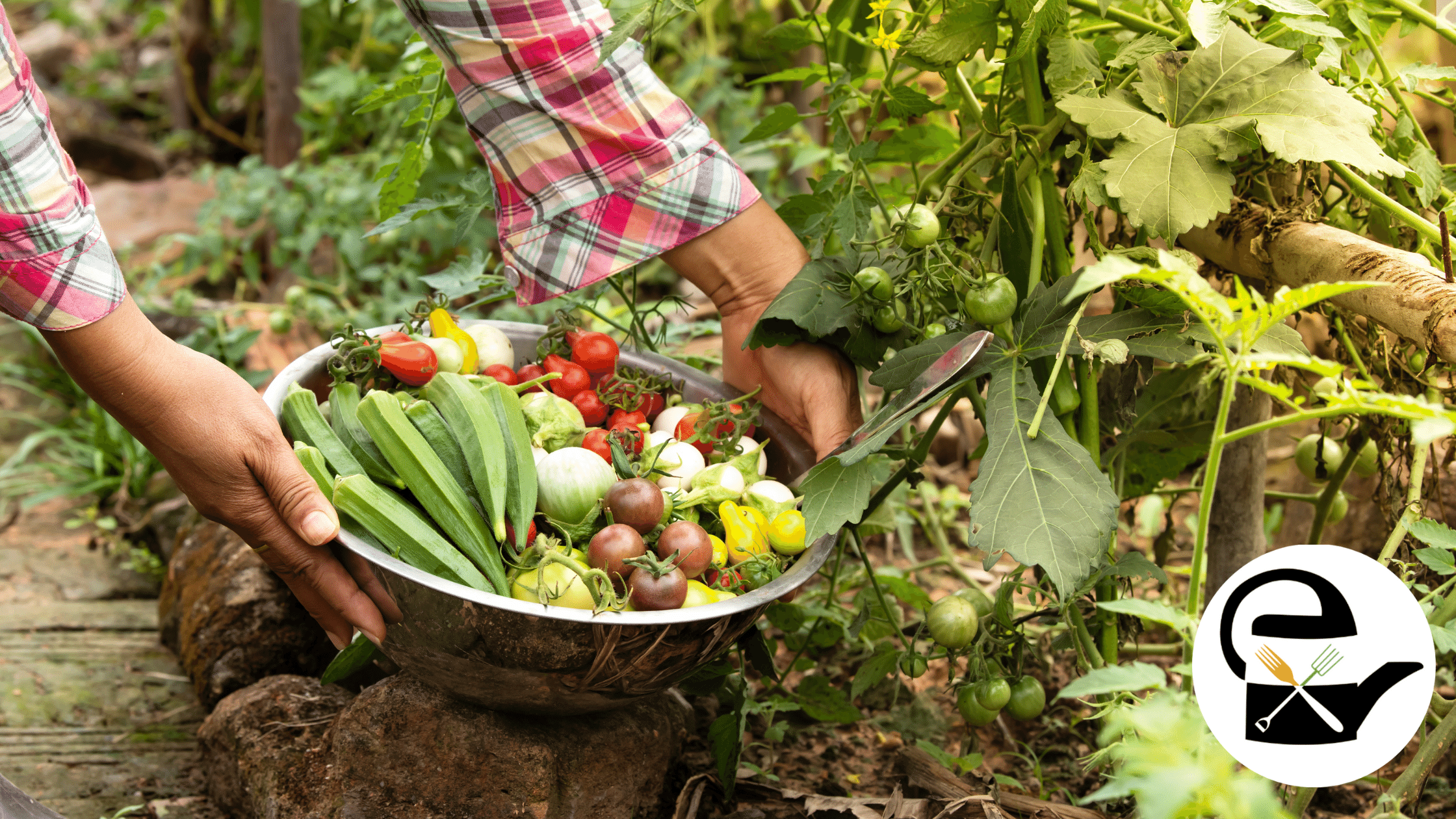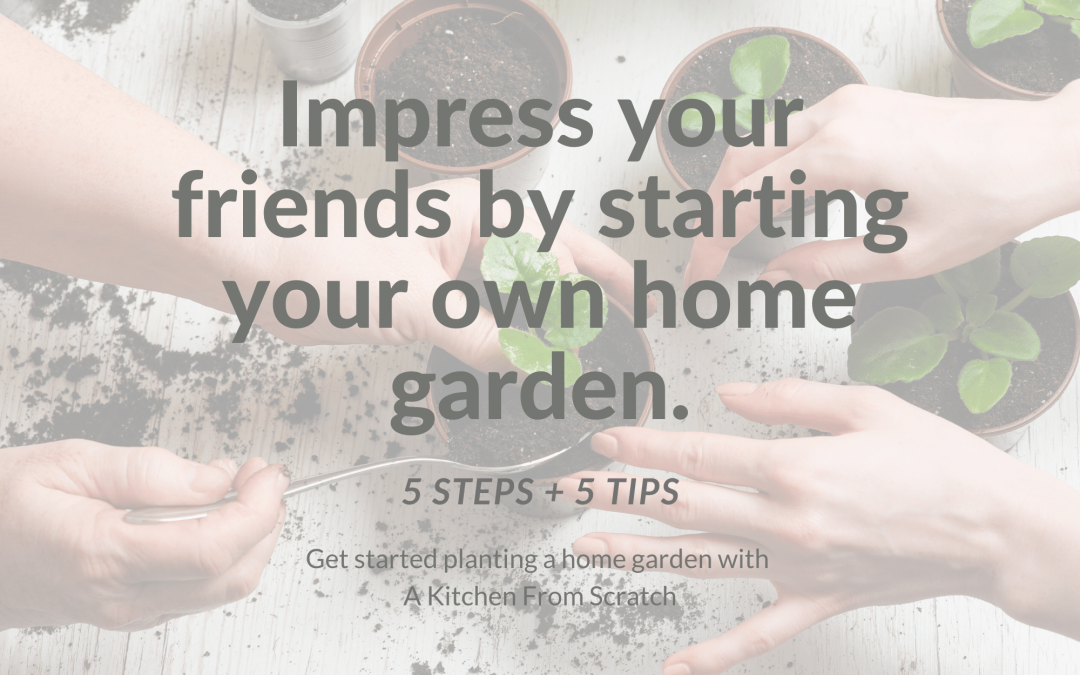If you are looking to begin your home gardening journey, you are in the correct place.
Follow these five steps, and you will have a simple home garden plan to get those seeds or plants in the soil by Spring. Although it is more fun to start in early Spring, if that stresses you out, know the planting season runs well into July for certain warm weather plants–jump in when you are ready!
Move along if you have no appetite for learning, failure, or having many more reasons to laugh at yourself. Do it, and you’ll get good things to eat for yourself and others, lots of fresh air and exercise.
Truth: Growing a garden needs only 3 things: dirt, sun, and water. And yet, about 66% of the population doesn’t even attempt a seasonal garden.
In 1943 (during WWII), 40% of the vegetables consumed in the US were grown in backyard gardens (called Victory gardens).
Do you know the #1 reason for not planting a garden?
People think growing a garden is complicated and are afraid to fail. Are you afraid to fail? Change your perspective. Failing is learning. Every gardener has had epic failures that lead to significant victories.
You may even save money in the long run. But trust me, you’ll also learn more than you desired about the tenacity of weeds, the irregularities of mother nature, and the dietary preferences of wildlife and insects. It’s all part of the learning process.
Remember to breathe; remember to laugh—especially at yourself—and you’ll see why people like us start our garden planning during the dark days of January. Let’s get started!
Step 1: Commit to a Home Garden
Commit:
I hear you; you want to grow your own home garden, but you don’t know where to start? Remember, your garden can be as simple or elaborate as you wish.
There is a solution to anything that might be stopping you. What do you really have to lose?
Find your “why”: Without a solid reason to accomplish starting a garden, I can assure you gardening will not make it to the top of your priority list. What is your why?
Here’s my why, “Research about microbes in the soil has the same effects as antidepressants without the side effects.” Take it from me; gardening is therapy.
A garden will take you outdoors, give you fresh air, sunshine, and exercise. Unplug, get some overalls on, and get outside.
I put a poll on Facebook’s Mother Earth News Garden Group (14,000 members) and got some amazing responses. This is their why: “I like to go grocery shopping in my backyard.”; “I love to eat fresh vegetables.”; “I garden to teach my kids where food comes from.”; and “I just want to be healthy.”
But, the most common answer I get is, “I want to simplify my life and connect to the earth.”
Commit to Something Bigger Than Yourself
If you have problems committing, you will benefit from investing in a group. The most feasible way to overcome the fear of commitment is to commit to trying something bigger than yourself.
In a group, you can draw upon others for both motivation and support.
Join our Facebook gardening lifestyle group. We will post upcoming garden-related classes and lessons learned from our own garden, both successes and failures.
We are products of our environment and if you have fresh vegetables sitting around, chances are you will consume them. Side effects of gardening include fresh produce and happiness.
Gardening is not a one size fits all, and you have to be clear on what it is you want to accomplish and how much time you are willing to spend tending, weeding, and harvesting.
On average, once everything is planted, we spend 2 hours a week weeding, harvesting, and preparing our weekly meal plan using produce, flowers, and herbs from our own large backyard garden. Don’t worry, a smaller raised garden could be maintained in just 20-30 minutes per week.
Step 2: Find a Home Garden Location
If you are not dreaming of rows of tiny greens, bees buzzing around fruiting trees, and flowers breaking through the wet soil, then you should start. Dreaming is a big part of gardening.
When you choose a location, it will require three things: Space, sunlight, and water.
The selection of the garden location is essential to making it part of your weekly routine. Make sure that you can lay your eyes on the garden often — easy access is better. Ideally, you should be able to see it while performing your daily tasks (e.g., from your kitchen or bedroom window).
If it is difficult to get to the garden because you need to trek across town, chances of a bountiful harvest are less likely. If you don’t spend time in or near the garden regularly, you may not see the signs of drought, emerging pests, diseases or weeds taking over. If any of these take hold of your plants, results may be discouraging.
Space:
Some plants, such as pumpkins and winter squash, take up a ton of space – plan accordingly. In a limited area, stick with continuous high yield plants such as tomatoes, beans, peppers, and cucumbers.
If you have a limited viable area, you can grow in pots on a sunny patio, up on a trellis, or try square foot gardening.
Start small as you may lose momentum when the sunny days of summer begin calling you to the pool or you get the urge to take a beach vacation.
The most desirable option is to test the SOIL for pH and nutrient levels before you plant or have a fertilizer plan. If you’re not ready for the commitment of these tests, consider adding good soil to your garden as you plant.
The disparity between perfect soil and what you have will mostly affect the yield of the crop, not necessarily the ability to grow plants.
Sunlight:
The best location is a SUNNY spot on the south side of your house. This applies to both seed starting (inside) and planting your seeds and/or plants outside.
If it’s not possible to find the best spot facing south, east, or west-facing should still allow for the required 6-8 hours of sun.
Most vegetables need direct sunlight for a minimum of six hours every day. Eight hours is ideal and will result in more hearty, bountiful crops.
Pay attention to the location you are planning and observe the shadows throughout the day. See where they go, and look for sunny spots.
Remember that as the season progresses, the sun will be higher in the sky. If you need to choose between morning or evening sun, the early sun will dry the dew on the plants and reduce the chances of fungal diseases.
Standing water on plant leaves can lead to fungal pathogens infecting your crops with foliar diseases.
A general rule when growing in the Northern Hemisphere is planting a garden on the south-facing side of your property. If you are planting rows, avoid shading your plants by planting north to south.
Home Garden Tip: Always plant your taller plants on the north end of the plot (unless you’re are intentionally trying to shade your plants).
Water:
No plant will grow without consistent WATER access. As with soil, watering systems range from in-ground automatic systems on a timer to the commitment of hand watering with a garden hose or watering can.
Mulching helps with water retention in your garden. The more consistent the plan, the better the yield. But know that lots of plants will produce with even a simple design.
An ideal garden plot needs consistent water access and soil that properly drains. Try for enough organic matter to hold in moisture. Vegetable plants will grow poorly in waterlogged clay or dry sandy soil.
You can determine poor drainage by the swampy smell, or looking for pools of water. Avoid sandy or gravelly soil that drains too quickly.
A sure sign that your plants are not getting enough water, they will crack like the desert floor. The sweet spot is somewhere in the middle.
If your location does not have a sweet spot, you may have to build a raised bed and add nutrient-rich loamy soil. Raised beds are an investment in the beginning, but you will have better harvests in the long run.
Raised beds can be made out of a plethora of materials, but choose wisely as many available materials are treated with toxic chemicals that can seep into your harvest. Never ever use railroad ties for garden beds. Creosote treatment is toxic to people and pets.
Garden beds can also be very decorative and add more than just a harvest to your backyard yarden.
Remember not to let your excitement for a cool Spring planting rob your Summer fun.
Now that you know what you need to select the perfect location, you will soon be enjoying your very own homegrown goodness.
Step 3: Make a Home Garden Plan
When do I start planting?
Use your printable Seasonal Garden Planner by Month to plan out your gardening season.
Knowing when to start planting is vital. The last frost is the first time you can consider starting plants in the ground. Don’t let your enthusiasm get you in too much of a rush, an extra week or two is better than burning your plants. Last year, we planted our tomatoes the week before Mother’s Day. We had extra tomatoes so we left them in the greenhouse. Two weeks later, the greenhouse tomatoes were twice as big!
Waiting is also cheaper than buying tons of fancy contraptions to warm your plants. Utah’s average growing season starts May 15 and ends Oct 25. Making our frost-free growing season only 163 days.
Search HERE for your locations yearly average. This is the average date, meaning there is a 50% chance this year’s frost will visit a week or two before or after. Think of these dates as bookends to your gardening.
Once you have a general idea, you will know how many days are in your growing season. You can stretch this time with some tips and tricks.
The United States Department of Agriculture recommends that you start with finding your geographical hardiness zone. Refer to the USDA zone map.
** The interactive zone map will show you the average annual extreme minimum temperature based on 1979 to 2005. For example, my location by zip code is Zone 7a, with a temperature range of zero to five degrees.
**There are plenty of websites with interactive information based on your zip code. Make sure you use one that is based on data collected by an official organization such as the USDA, National Oceanic and Atmospheric Administration (NOAA) or National Centers for Environmental Information (NCEI).
Planting too early can also end your garden dreams before you even begin. Unless you want to baby your starts by keeping them warm with blankets, water walls, milk jugs, or other devices made for extending the growing season, wait for the last frost.
I have done all of the above things, but now that I have little ones, I am less likely to go through the extra effort. Observe the weather before planting outdoors, and you will be harvesting sooner than you think.
Now that you know your hardiness zone and how long your growing season is, you can start to think about the seeds you want to try. I start with local nurseries or companies that have seeds, specially made for my growing Zone.
What should I grow?
The key to a successful garden is a proper plan for what you want to grow now that you have a location to make it happen.
A garden is very personal and dependent on many aspects of the life you have created. Remember that gardening is a practice, and the best-laid plans may go awry. They can sometimes blossom into more than you can imagine. If you haven’t already ordered your seed catalogs or subscribed to a few to scavenge online, you should.
The descriptions of all the vegetable possibilities will make you want to quit your job and become a full-time gardener. Seriously, grab a warm cup of tea and enjoy; my husband reads the news–I “read” seed catalogs.
The first step is to make a list of vegetables that frequent your kitchen. What kind of food do you make in your kitchen? Do you enjoy a particular ethnic cuisine?
In our kitchen, we often go through cooking phases; our most popular is Korean, Indian, Southern, and what we call soul food or something in between. Grab your favorite cookbooks to get more ideas.
As we daydream, consider a theme garden with all the items you will need to make your favorite dishes.
My preferred theme is a salsa garden with a large variety of tomatoes, garlic, onions, chili peppers, and cilantro.
Theme plots:
Italian garden plot would include Roma or plum tomatoes, broccoli raab (rapini), radishes (radicchio), arugula, parsley, holy basil, and Florence fennel.
A Polish garden plan must consist of plenty of horseradish (seriously more than you think you need), cabbage, and onions.
An Asian plot would need soybeans, Chinese cabbage, snow peas, bok choy, bunching onions, Thai basil, and daikon radishes.
If Latin American cuisine is more your style, you will want an assortment of tomatoes, black beans, various chili peppers (depending on how hot you like your chili), and cilantro.
Must-haves for a tea-themed garden include mint, lemon basil, pineapple sage, anise hyssop, stevia, lemongrass, chamomile, lemon verbena, and rose hips.
The list is endless, only include the items that fit your lifestyle and personal tastes, or you will be zucchini bombing your neighbors with unwanted produce!
Your garden is a reflection of the kind of foods you like to eat.
Now is the time to determine what you or your family will eat out of the garden. Make a list of your chosen plants. Once you have your list, plant them based on outside temperatures.
Some seeds can be planted “as soon as the soil can be worked” (e.g., peas), and some need consistent warm weather (e.g., tomatoes and peppers). Making a list now will ensure you plant them in their preferred climate.
Here is a list of the most prosperous vegetables to grow (in order of when you will plant them):
“As soon as soil can be worked” refers to how wet the soil is. Form a handful of soil into a ball in your hand. If it crumbles apart with a slight touch of your finger, it’s time to plant. If it holds together and requires pressure to break apart, it is still too wet. If it won’t form a ball, you can plant, but you’ll need to start your watering plan.
Soil temperature above 40F: Pea, Spinach, Kale, Lettuce, Onions
Above 60F: Radishes, Spinach, Onions, Lettuce, Arugula, Beets, Peas, Chard, and carrots
Above 70F: Tomatoes, Zucchini, Cucumber, Green beans, Potatoes, Pumpkins, Eggplant
This list is not all-inclusive. If you will eat it, try to grow it!
My motto in life is usually “go big or go home,” but when it comes to gardening, that is not the case. When I first began gardening, I loved every little green start, and I planted every blooming one.
Naturally, I wound up with a jungle that was more than I could personally tame. It was magnificent, but it was disastrous.
Home Garden Tip: Start small and plant less, and I promise you will get more than you need.
Step 4: Choose the Best Home Garden set-up:
Depending on your space, there are many ways to set up your garden. Traditional row gardening (e.g., WWII Victory garden) is excellent if you have a larger space.
The traditional garden design makes setting up a drip system simple and gives you the option to readjust your plot year after year.
Raised beds are the second most popular. They are great if you have a more manicured space with mature trees where the root system could potentially prevent garden beds from thriving or poor soil.
Raised beds can extend your garden season but can drain too quickly if you don’t have fabulous soil. Also, if you are tall or in a wheelchair, this is a great way to have an elevated garden.
Home Garden Tip: If you have a small space, consider square-foot, vertical, and container gardening as options to get “bang for buck”.
Choose a garden set and plot the space.
Use your Printable Garden Plot Set Up Grid to dream about your garden set up and what it will look like in full bloom. This is where you get to be creative.
- Traditional – This is what my grandmother had on her farm, unlimited space to plant north-south facing rows (e.g. WWII Victory Gardens).
- Raised bed – Normally used for poor soil, it allows the gardener to add bags of soil.
- Square Foot – Normally used for small garden areas with a large variety of herbs, flowers, and vegetables.
- Straw-bale – Can be used on a solid surface without requiring anything permanent.
- Burlap bags – Creative way to grow potatoes.
- Container – Can be used for a tiny garden area or a patio garden.
- A vertical- Growing up can be a creative and attractive way to grow in a small urban space.
- Community – Most cities have a community garden program if you can’t find a suitable garden spot at your home location.
Step Five: Get your Home Garden Seeds
Now that you have your list, you will need to find some seeds.
Remember to start small. When I first ordered all my seed packets, I was over-enthusiastic and planted the entire package. Each seed packet contains enough seeds to feed a small colony. Please don’t plant them all unless you are a master gardener or have no summer plans. My chickens were fat and happy that year.
Learning how to choose and buy seeds for the upcoming garden season is the best way to spend any cold winter day. Gardening from seed is a rewarding and budget-friendly way to start gardening.
The first thing you will need to start a home garden is the seeds for the plants you want to grow. Browsing the latest edition of seed catalogs will inspire your next growing season. Here are a few questions to help you become a seed-buying pro:
Is it better to buy plants or seeds?
Buying seeds is cheaper than vegetables. Seeds can be purchased at the grocery store you frequent, local nursery, or any home improvement store near you.
Home Garden Tip: If you are interested in becoming a self-sufficient gardener, you can harvest your own heirloom seeds year after year.
But if you’re a beginner, then you can find others who are willing to share.
Where is the best place to get home garden seeds?
Seed Exchanges: Do a quick internet search, and you may be surprised to find that some local groups exchange seeds. Most of these seeds are free; the cost is in exchange for the return postage in shipping and handling.
Local Gardening Clubs/Organizations: Horticultural societies, arboretums, or public gardens will often have seeds available.
Seed Swap Groups: These are both paid and free groups that swap seeds, either way, you will save money in the long run. Facebook is becoming a popular place for such online groups.
See Libraries: This is similar to a regular library where you check out the seed and return them at the end of the season. This is where you will find reserves of unusual and endangered seeds.
This option is free and a great starting place for beginners. seed library
Online Forums: such as Houzz, where you can post a request publicly or privately via a forum. They may also have https://www.houzz.com/discussions/seed-saving.
Where can I buy seeds?
This is my favorite seed supplier because they sell seeds precisely that will flourish in my growing Zone:
https://www.trueleafmarket.com/
Keep in mind, The United States Department of Agriculture assigns zones based on the average annual extreme minimum temperatures. Find your plant hardiness zone here. Look for your local see companies and make sure they sell for your growing Zone.
Home Garden Tip: Many seed companies sell seeds for a deep discount at the end of the season. Check out your local seed companies.
How do I know what will grow in my Zone?
Seed catalogs offer a pleasing selection of vegetables and flower seeds with the growing zones clearly labeled to prevent you from purchasing seeds that will not grow in your area.
Winter is the time to order seed catalogs.
The descriptions of each seed make it hard to narrow down your spring wish list for buying and saving seeds.
Here are a few catalogs: True Leaf Market 2019 PDF Seed Catalog digital download or a print version is $5 and includes a coupon for $5 off your next order.
https://www.trueleafmarket.com/products/product-catalog-mountain-valley-seeds?
https://www.burpee.com/catalogrequest, they also have an app.
https://www.seedsofchange.com/download-our-ecatalog. This is a downloadable e-catalog.
Most of the seed companies are going to online catalogs to be enjoyed on your desktop or mobile device.
The most popular versions include a high-res interactive version for easy online browsing and a lower-res PDF version for downloading printing, or offline browsing.
What is the best kind of home garden seed?
Heirlooms are the best if you want to use the plant to get seeds the following year. Heirloom seeds, unlike a hybrid, can grow year after year.
When a seed is a hybrid, it is genetically modified to have certain traits, often at the cost of nutrients and taste. Heirloom is almost always organic and will grow “true to seed” or the same plant every time.
How long do home garden seeds last?
Most vegetable seeds remain good for an average of three years when kept in a cool, dry place.
The type of seed can affect how long a seed stays viable. Some seeds, like corn, okra, parsley, or peppers, will last about two-years. Garden Seeds, like pumpkin, beans, peas, tomatoes, and carrots, can stay viable as long as four years. Cucumber, lettuce, radish seeds can remain viable up to six years if stored properly.
The trick is keeping seeds in a consistently cool and dry place to ensure they last longer than the projected lifespan. I have planted nine-year-old viable seeds that produced more than I anticipated.
Well, now you have a few ideas of where to get seeds and catalogs to ignite your garden dreams. Hopefully, this will add a little extra to get you closer to spring planting.
Now go and get started ordering or downloading your catalogs and start your seed wish list.
You will need a few tools once it’s time to plant your garden. Check out my Gardening Tool Basics.
Happy garden dreaming. Let us know if you have any questions.





